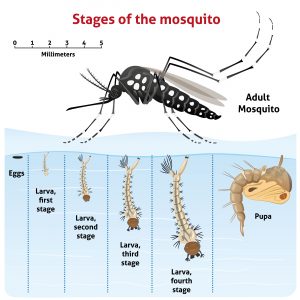It promises to be a hot summer and, combined with wet weather, an ideal environment for mosquitoes. Bites from mosquitoes can transmit a number of serious diseases, one of which is the West Nile virus. West Nile is the leading cause of mosquito-borne illness in the continental United States.
West Nile is in the flavivirus family and cases have been reported this year in states are far apart as South Dakota, Connecticut, Texas, and Colorado. It can infect a wide variety of hosts, including at least 30 species of mammals and birds, including horses, dogs, and cats.
(Note: Everyone thinks West Nile is named after the Nile river in Egypt, but it’s actually named after the West Nile district of Uganda, where the virus was discovered in 1937.)
Symptoms of West Nile
Luckily, most people who become infected with West Nile virus don’t experience any symptoms at all. If you’re in the unlucky one-in-five minority, symptoms normally appear 2–14 days after being bitten by an infected (usually, Culex species) mosquito or, rarely, receiving a blood transfusion or organ transplant from an infected person. You can expect to see:
- Fever
- Body aches
- Headache
Some victims will experience skin rashes on the torso, eye discomfort, and swollen lymph nodes as well. Mild cases recover in a few days to a few weeks and receive lifelong immunity thereafter.
Severe West Nile Symptoms
About 1 out of 150 very unlucky patients will develop a sometimes-life-threatening sickness, mostly after the nervous system. Folks over 60 years of age are at highest risk, as well as those with a history of chronic illness of impaired immune systems.
Severe symptoms include:
- Headache
- High fever
- Tremors
- Neck stiffness
- Muscle weakness
- Confusion and disorientation
- Paralysis and coma
When it affects the nervous system, West Nile can cause something called “encephalitis.” There are various types of encephalitis, including Japanese encephalitis, St. Louis encephalitis, Murray Valley encephalitis, and others. All take a while to improve and can cause significant damage, sometime permanent. A 10 percent death rate is seen in the worst cases.
Treating West Nile Virus
There is no specific treatment for West Nile other than treating symptoms as they occur, such as fever. The worst cases require hospitalization and, often, intensive care. A vaccine has not yet been developed. Fortunately, most will recover, although some continue to have long-term problems with weakness and fatigue.
The good news is that human and some animals, like horses, are “end hosts,” meaning that they may become infected, but won’t spread it to others of their own species. Animal to human transmission, however, can occur. If you’re caring for a sick horse, for example, use gloves and disinfected equipment used.
Preventing West Nile Virus
 mosquito larvae in empty flowerpot
mosquito larvae in empty flowerpot
The best way to prevent West Nile virus transmission is to reduce the local mosquito population. If you live in an at-risk area, you can protect yourself by:
- Using DEET or other mosquito repellent (even indoors in areas without AC. Picaridin, IR3535, and oil of lemon eucalyptus are EPA approved.
- When outdoors, wear long-sleeved shirts and long pants tucked into socks or mesh outfits. Mesh outfits are commercially available and inexpensive.
- Clothing can be treated with 0.5{ebf8267f808eac43d24742043db51eeeb004db6334271e1bb6fe8c21c7925753} permethrin, an effective repellent. It can’t, however, be used on skin.
- Keep windows and doors shut if you have air conditioning. Use window and door screens if you don’t, and mosquito netting on beds and cribs.
- Eliminate standing water wherever possible. Get rid of tin cans, flowerpots, old tires, bird baths, and anything that can hold standing water. Even your pet’s water dish can support mosquito larvae. Clear clogged gutters.
- Avoid activities at dusk, dawn, or early evening when most mosquito species are especially active.
Joe Alton MD


 Culex species mosquito (CDC)
Culex species mosquito (CDC)
 Dr. Alton
Dr. Alton



